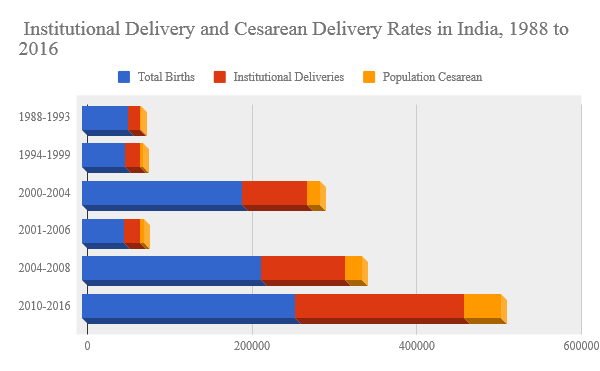India’s C-Section Conundrum: Too many or too few? It’s both!

Photo by Luma Pimentel on Unsplash
By Spoorthy Raman, Research Matters; NHI March 31, 2019
A grapevine in India’s maternity scene is that cesarean births have become rampant in recent years and vaginal delivery is almost a miracle. Although natural, doctors advice against vaginal birth in cases where pregnancy-related complications could endanger the lives of the mother and the baby. Instead, a surgical procedure, called C-section or cesarean section, is performed where the uterus is cut open to deliver the baby. Undergoing this procedure means a lengthy hospital stay and skyrocketing medical bills, with hospitals raking up profits. Are we then forced into C-section deliveries or is the “increase” in such deliveries justified? Turns out, India’s cesarean birth numbers are both excessive and inadequate!
In a new study, researchers from the Paris Descartes University (Université Paris Descartes), France, have explored the trends, regional variations, and socioeconomic disparities in cesarean births in India during the years 2010-2016. They found that overall, India has about 17.2% cesarean births annually, a number that is slightly higher than the threshold of 15% recommended by the World Health Organisation, which says that anything beyond could lead to increased maternal and perinatal morbidity. The findings of the current study are published in the journal JAMA Network Open.
The researchers of the study used data from the fourth round of the National Family and Health Survey conducted between 2015 and 2016, by the Indian Institute for Population Sciences, Mumbai. During the survey, 699,686 girls and women aged between 15 to 49 years were interviewed, and information on their last three pregnancies since January 2010 was collected. In total, the dataset had information about 259,627 births.
Since the late 1980s, there has been a slow increase in the number of cesarean births in India as witnessed by various demographic surveys. In the last decade, this has doubled due to the decrease in home birthing without medical supervision. Programs like the Janani Suraksha Yojana and Janani Shishu Suraksha Karyakram have provided access to modern delivery facilities by incentivising women to use the free prenatal and postnatal care in public health centres. As a result, during 2010-2016, about 78.9% of annual births were recorded in hospitals.

Institutional deliveries and cesarean deliveries in India between 1988-2016 [Data Source].
The current study found that although the overall caesarean birth is about 17.2% annually, there is a significant disparity in the number of such births, with some parts recording unnecessary cesarean births while others had abysmal numbers. “The emerging situation also points to significant regional and sex disparities, with a substantial deficit of cesarean deliveries among underprivileged groups and almost two million excess cesarean births every year among more advanced sections of the population”, say the authors, talking about the findings.
The results also show that about 4.38 million births were delivered through a C-section procedure annually during 2010-2016. Despite the progress in access to maternal care, home deliveries accounted for about 30% of births in populous states of North India like Bihar and Uttar Pradesh. However, in South India, and the prosperous states of Maharashtra and Punjab, about 90% of births were institutional, meaning they took place in hospitals.
The cesarean birth rates varied from about 10% in less-developed states of Rajasthan, Jharkhand and Bihar to well over the threshold of 15% in South India and other prosperous states. The researchers analysed data from 640 districts of the country and found that a vast stretch of North India, including large patches of mountains or forests in Northeast India, Uttarakhand, Chhattisgarh and Odisha, recorded less than 10% of cesarean births. On the other hand, all South Indian states accounted for over 35% cesarean births, with the highest being Telangana at 57.7%. In 21 of the districts analysed across the country, more than half of the births were delivered by cesarean delivery.

Cesarean rates across the country [Image credits].
The study also found that the cesarean birth rates varied based on socioeconomic factors of the population. Poorer sections of the society had about 4.4%, and the more affluent sections had up to 40%. “The less privileged 40% of births accounted for only 10% of all cesarean deliveries, whereas less than 20% of the births among better-off populations represented half of cesarean deliveries”, point out the authors. The government facilities had a healthy cesarean rate of 11.9% in 2015 to 2016, whereas in private clinics, it grew from 27.5% to 40.8% during the same period.
Interestingly, about 21% of the deliveries were at home due to limited access to institutional deliveries for economic or accessibility reasons. However, of the 27.1% of births delivered in private clinics, a record level of 40.4% were cesarean births. Here lies the conundrum of numbers—India recorded an estimated annual excess of 1.8 million cesarean deliveries from 2010 through 2016, concentrated in more advanced regions and affluent classes. During the same period, a yearly deficit of 0.5 million cesarean births were recorded among underprivileged populations.
Do cesarean births then mean healthy mommies and babies? Not necessarily, says the study. Although populations with lower cesarean rates of less than 10% had higher maternal and neonatal mortality, Telangana, the state with the highest cesarean birth rate, did not have the lowest mortality rates.
As India progresses rapidly in making maternal care accessible, it is estimated that by early 2020, all births could take place in health facilities. While this is good news, the unabated increase in C-section deliveries is a concern. Hence, monitoring cesarean birth rates could help understand the drivers behind it.
“In urban areas and among the middle class, cesarean rates have already reached levels consistently higher than what is considered medically justified. Effective interventions and policies targeted at women and health care professionals to reduce unnecessary cesarean deliveries will be required in India to avoid growing inequalities in access to cesarean and unnecessary procedures”, conclude the researchers.
Image and news source: Research Matters








